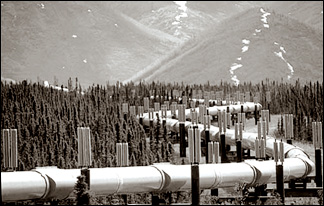Saving energy by fighting friction
Here's the rub: Resistance alone may burn as much as one-third of the
world's power. Have you ever tried drinking a milkshake through a skinny
straw? It can leave your cheeks burning for a piddling payoff. Replace
it with a fatter straw, and the cheeks barely have to work at all. Why
such a difference? Friction. The liquid rubs the straw.
 And that same force slows the traffic in all kinds of pipes
throughout our economy. Strange as it may sound, the energy implications
of skinny pipes are huge: More than one-quarter of the electricity
consumed by American industry powers pumps and fans that push along
stubborn gases and liquids. And that same force slows the traffic in all kinds of pipes
throughout our economy. Strange as it may sound, the energy implications
of skinny pipes are huge: More than one-quarter of the electricity
consumed by American industry powers pumps and fans that push along
stubborn gases and liquids.
So the need for shorter, squatter tubing has never been greater. Fat
pipes are part of a barely recognized industry that may soon become much
more prominent: friction fighting.
Estimates indicate that overcoming resistance accounts for as much as
one-third of the energy we consume on the planet. Now, with oil topping
$80 per barrel, the cost of each rub, chafe, or blast of headwind is
soaring. But such costs also bring opportunities for those with
high-tech fixes.
The fight against friction is moving from garages and fix-it shops
right into strategy sessions in the corner office. It's driving
innovation across the global economy. New nanotechnologies, for example,
combat the rubbing and clinging of objects in motion with ingenious thin
coatings and ball bearings barely the size of molecules.
Chemical giants such as DuPont (DD ) and BASF (BASFY ), leaders in
the $40 billion lubrication market, are developing new polymers and
low-friction plastics for car engines and airplanes. And design shops,
like Rumsey Engineers of Oakland, Calif., are installing-you guessed
it-fat pipes.
The company recently used them to double the efficiency of the
air-conditioning system at the Oakland Museum. "We cut friction in
half," says company President Peter H. Rumsey.
Designers in the battle against friction draw lessons from the
streamlined forms of plants and animals. One team at Mercedes-Benz (DAI
), for example, has modeled a concept car on the smooth-swimming form of
a boxfish.
The "Bionic" car slices neatly through strong winds on the open
highway. Better aerodynamics leads to cars that get 70 miles per gallon
of gas, according to Mercedes, 30% more than a standard design. The
opportunities for savings are even greater in trucks.
When they're rolling at highway speeds, they burn two-thirds of their
fuel just to overcome the drag of wind. Researchers at Georgia Tech
report that streamlining truck design could reduce this drag by 12%,
saving 1.2 billion gallons of fuel per year in the U.S.
The nanotech players focus mostly on new substances. ApNano Materials
makes chemical spheres called fullerenes, each one so small that several
billion scarcely fill a single teaspoon.
When blended into traditional motor oils, these balls leave a smooth
film several atoms thick on the metal they touch. Tests by Israel 's
technical institute Technion show that they can reduce friction by as
much as 50%. ApNano founder Menachem Genut says his fullerenes will be
available as an additive in name-brand fuel oil within a year.
At DuPont's giant Experimental Station in Wilmington , Del. ,
friction is an age-old adversary. (Teflon, first developed to fight this
problem on frying pans, later turned up as a lubricant in jet engines.)
Now the drive for fuel efficiency is forging new markets for Dupont's
most exotic products-including one relic from the Cold War.
In the late 1950s, researchers at DuPont commercialized a molecule
with astounding properties. It held up even in furnace-like conditions
where lesser lubricants broke apart. They called it Krytox.
The only trouble: Since it was produced from calcium fluoride, a
mineral that's expensive to mine, Krytox cost too much to make. DuPont
shelved it. But in 1967, a buyer finally surfaced: Following a deadly
fire during a launchpad test, NASA needed a nonflammable lubricant that
could withstand tremendous heat.
Krytox is still pricey. In some forms it can cost more than $1,000 a
pound. But its market is growing in double digits, and far beyond NASA.
Why? Automakers face a host of challenges that demand better
lubrication. First, they're under pressure to build hotter engines,
which are far more fuel-efficient than cooler ones, but harder to
lubricate.
At the same time, today's engines are lighter and smaller, which
leaves less room for the flow of cooling air. These sizzling engines
must do their work quietly-a key selling point for luxury cars-and must
make good on the common 100,000-mile warranty.
To meet such specs, automakers are paying top dollar for Krytox and
dabbing key components with the Space Age oil. It's as if the world's
awakening to the costs of friction, says DuPont's Senior Engineer Carl
Walther. "The market's coming to us." |
